Cultural Safety Position Statement
VerifiedAdded on 2023/03/20
|9
|2046
|66
AI Summary
This document discusses the importance of cultural safety in healthcare, specifically in CDU Aged care centre. It explores the role of effective communication in creating a culturally safe environment and the relationship between health literacy and communication. The document also highlights external influences contributing to safe cultural practices in healthcare and addresses the barriers in implementing the position statement, along with possible solutions.
Contribute Materials
Your contribution can guide someone’s learning journey. Share your
documents today.
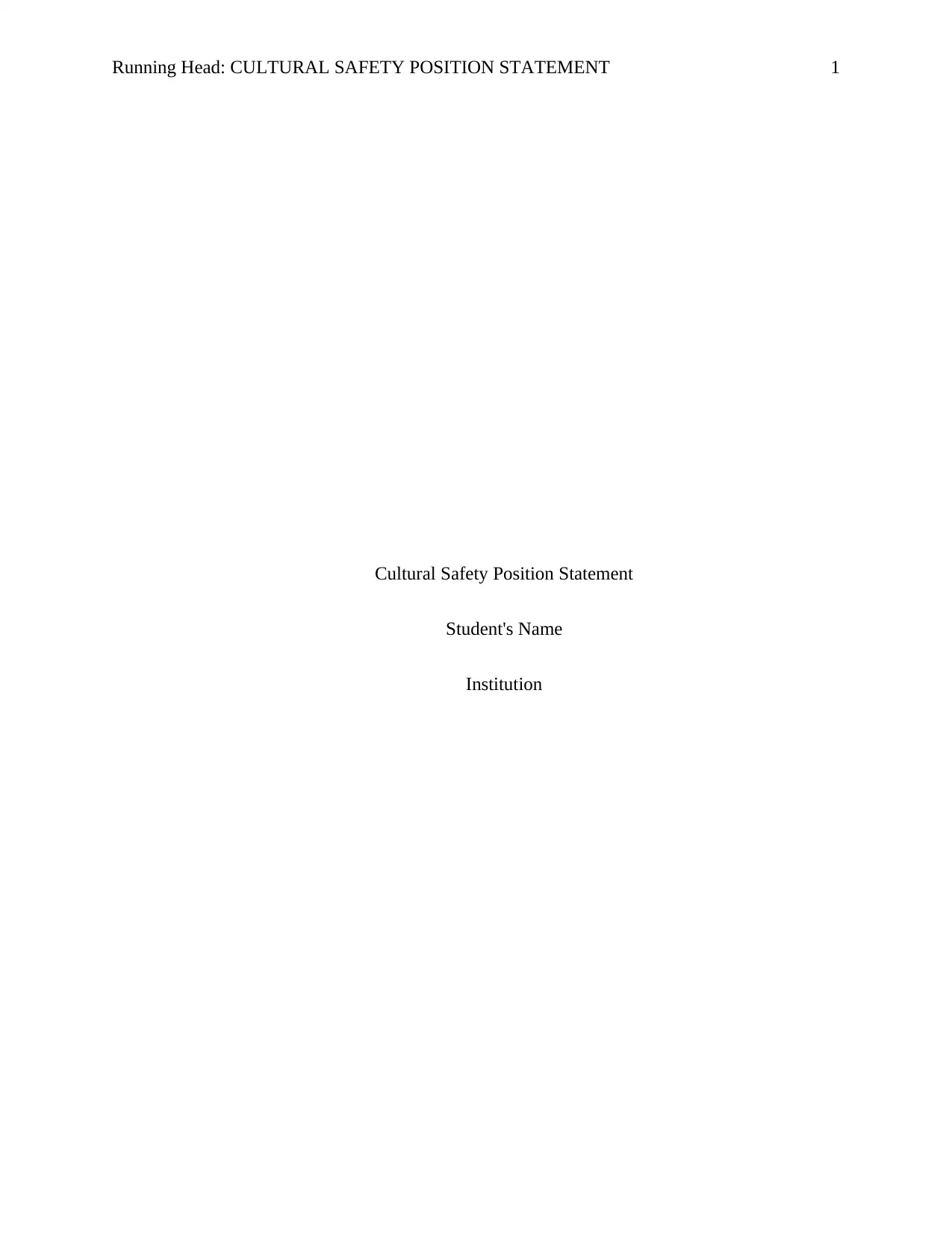
Running Head: CULTURAL SAFETY POSITION STATEMENT 1
Cultural Safety Position Statement
Student's Name
Institution
Cultural Safety Position Statement
Student's Name
Institution
Secure Best Marks with AI Grader
Need help grading? Try our AI Grader for instant feedback on your assignments.
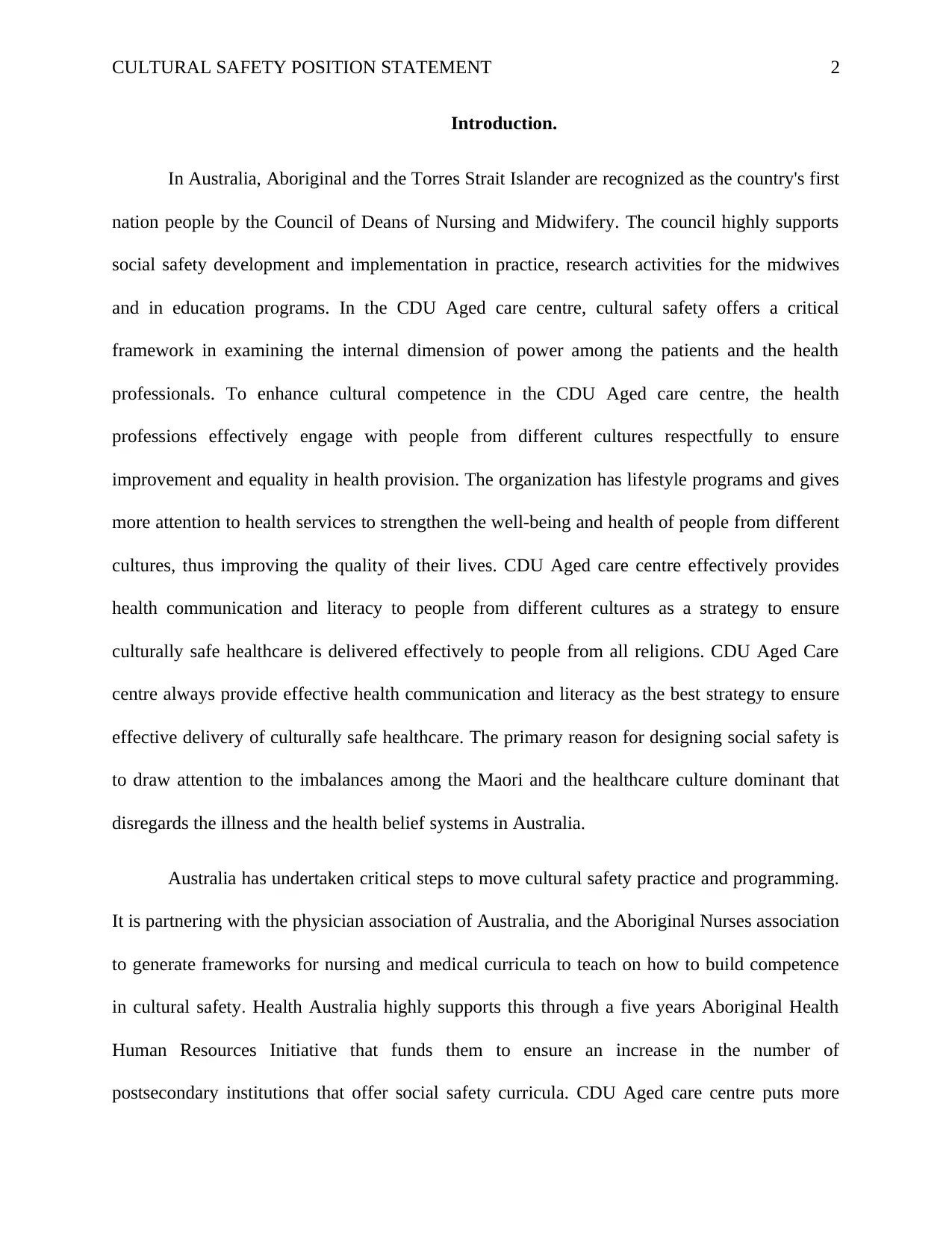
CULTURAL SAFETY POSITION STATEMENT 2
Introduction.
In Australia, Aboriginal and the Torres Strait Islander are recognized as the country's first
nation people by the Council of Deans of Nursing and Midwifery. The council highly supports
social safety development and implementation in practice, research activities for the midwives
and in education programs. In the CDU Aged care centre, cultural safety offers a critical
framework in examining the internal dimension of power among the patients and the health
professionals. To enhance cultural competence in the CDU Aged care centre, the health
professions effectively engage with people from different cultures respectfully to ensure
improvement and equality in health provision. The organization has lifestyle programs and gives
more attention to health services to strengthen the well-being and health of people from different
cultures, thus improving the quality of their lives. CDU Aged care centre effectively provides
health communication and literacy to people from different cultures as a strategy to ensure
culturally safe healthcare is delivered effectively to people from all religions. CDU Aged Care
centre always provide effective health communication and literacy as the best strategy to ensure
effective delivery of culturally safe healthcare. The primary reason for designing social safety is
to draw attention to the imbalances among the Maori and the healthcare culture dominant that
disregards the illness and the health belief systems in Australia.
Australia has undertaken critical steps to move cultural safety practice and programming.
It is partnering with the physician association of Australia, and the Aboriginal Nurses association
to generate frameworks for nursing and medical curricula to teach on how to build competence
in cultural safety. Health Australia highly supports this through a five years Aboriginal Health
Human Resources Initiative that funds them to ensure an increase in the number of
postsecondary institutions that offer social safety curricula. CDU Aged care centre puts more
Introduction.
In Australia, Aboriginal and the Torres Strait Islander are recognized as the country's first
nation people by the Council of Deans of Nursing and Midwifery. The council highly supports
social safety development and implementation in practice, research activities for the midwives
and in education programs. In the CDU Aged care centre, cultural safety offers a critical
framework in examining the internal dimension of power among the patients and the health
professionals. To enhance cultural competence in the CDU Aged care centre, the health
professions effectively engage with people from different cultures respectfully to ensure
improvement and equality in health provision. The organization has lifestyle programs and gives
more attention to health services to strengthen the well-being and health of people from different
cultures, thus improving the quality of their lives. CDU Aged care centre effectively provides
health communication and literacy to people from different cultures as a strategy to ensure
culturally safe healthcare is delivered effectively to people from all religions. CDU Aged Care
centre always provide effective health communication and literacy as the best strategy to ensure
effective delivery of culturally safe healthcare. The primary reason for designing social safety is
to draw attention to the imbalances among the Maori and the healthcare culture dominant that
disregards the illness and the health belief systems in Australia.
Australia has undertaken critical steps to move cultural safety practice and programming.
It is partnering with the physician association of Australia, and the Aboriginal Nurses association
to generate frameworks for nursing and medical curricula to teach on how to build competence
in cultural safety. Health Australia highly supports this through a five years Aboriginal Health
Human Resources Initiative that funds them to ensure an increase in the number of
postsecondary institutions that offer social safety curricula. CDU Aged care centre puts more
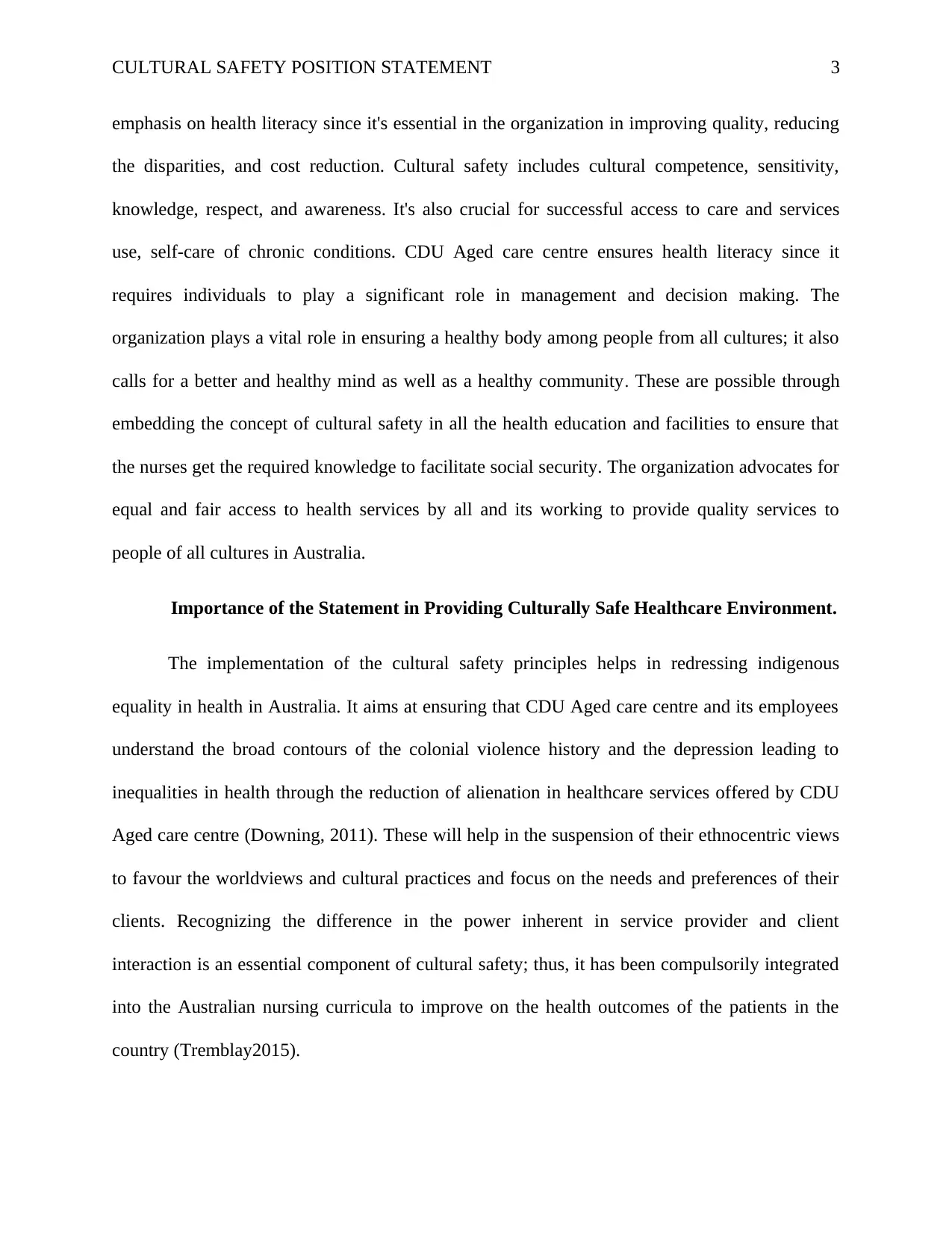
CULTURAL SAFETY POSITION STATEMENT 3
emphasis on health literacy since it's essential in the organization in improving quality, reducing
the disparities, and cost reduction. Cultural safety includes cultural competence, sensitivity,
knowledge, respect, and awareness. It's also crucial for successful access to care and services
use, self-care of chronic conditions. CDU Aged care centre ensures health literacy since it
requires individuals to play a significant role in management and decision making. The
organization plays a vital role in ensuring a healthy body among people from all cultures; it also
calls for a better and healthy mind as well as a healthy community. These are possible through
embedding the concept of cultural safety in all the health education and facilities to ensure that
the nurses get the required knowledge to facilitate social security. The organization advocates for
equal and fair access to health services by all and its working to provide quality services to
people of all cultures in Australia.
Importance of the Statement in Providing Culturally Safe Healthcare Environment.
The implementation of the cultural safety principles helps in redressing indigenous
equality in health in Australia. It aims at ensuring that CDU Aged care centre and its employees
understand the broad contours of the colonial violence history and the depression leading to
inequalities in health through the reduction of alienation in healthcare services offered by CDU
Aged care centre (Downing, 2011). These will help in the suspension of their ethnocentric views
to favour the worldviews and cultural practices and focus on the needs and preferences of their
clients. Recognizing the difference in the power inherent in service provider and client
interaction is an essential component of cultural safety; thus, it has been compulsorily integrated
into the Australian nursing curricula to improve on the health outcomes of the patients in the
country (Tremblay2015).
emphasis on health literacy since it's essential in the organization in improving quality, reducing
the disparities, and cost reduction. Cultural safety includes cultural competence, sensitivity,
knowledge, respect, and awareness. It's also crucial for successful access to care and services
use, self-care of chronic conditions. CDU Aged care centre ensures health literacy since it
requires individuals to play a significant role in management and decision making. The
organization plays a vital role in ensuring a healthy body among people from all cultures; it also
calls for a better and healthy mind as well as a healthy community. These are possible through
embedding the concept of cultural safety in all the health education and facilities to ensure that
the nurses get the required knowledge to facilitate social security. The organization advocates for
equal and fair access to health services by all and its working to provide quality services to
people of all cultures in Australia.
Importance of the Statement in Providing Culturally Safe Healthcare Environment.
The implementation of the cultural safety principles helps in redressing indigenous
equality in health in Australia. It aims at ensuring that CDU Aged care centre and its employees
understand the broad contours of the colonial violence history and the depression leading to
inequalities in health through the reduction of alienation in healthcare services offered by CDU
Aged care centre (Downing, 2011). These will help in the suspension of their ethnocentric views
to favour the worldviews and cultural practices and focus on the needs and preferences of their
clients. Recognizing the difference in the power inherent in service provider and client
interaction is an essential component of cultural safety; thus, it has been compulsorily integrated
into the Australian nursing curricula to improve on the health outcomes of the patients in the
country (Tremblay2015).
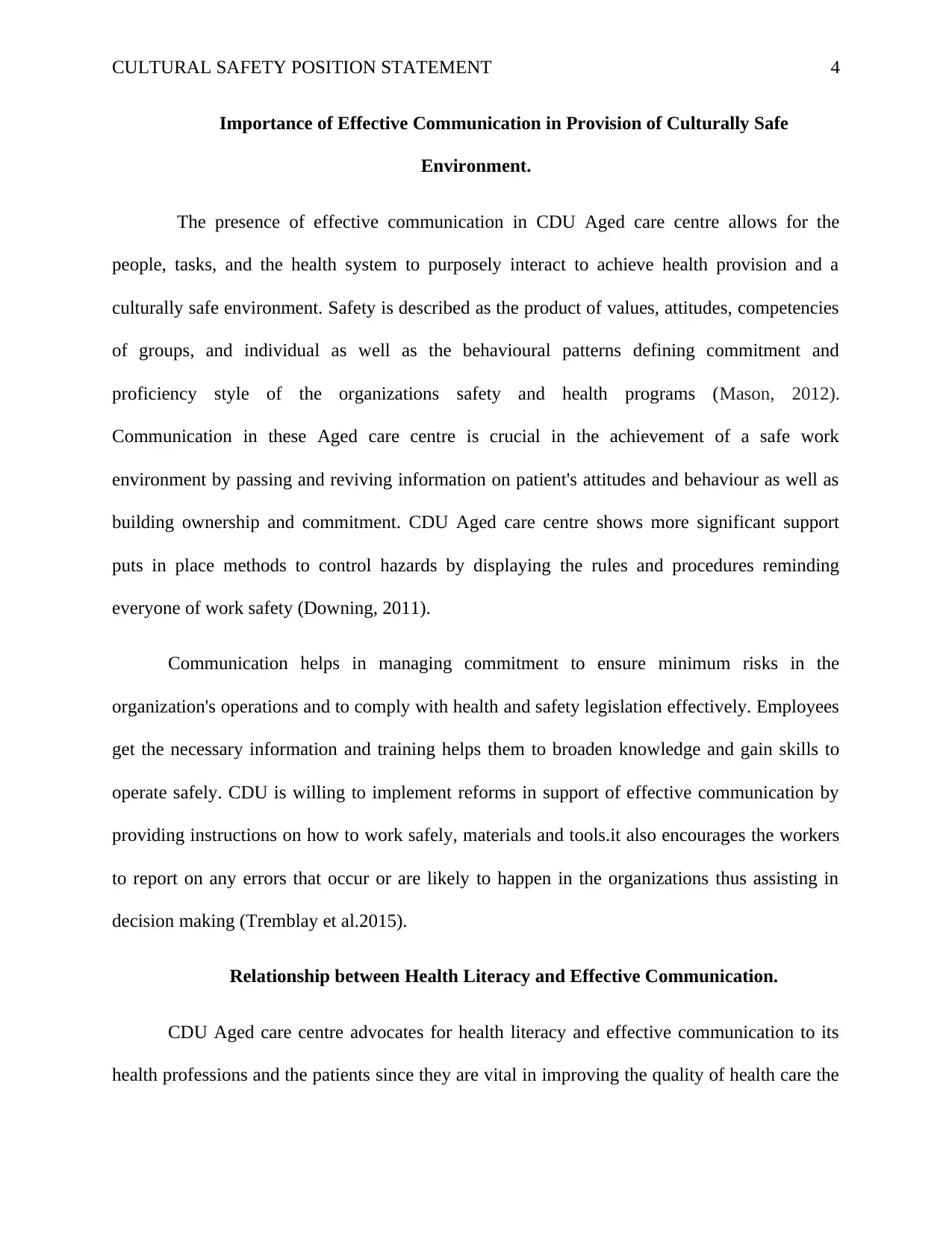
CULTURAL SAFETY POSITION STATEMENT 4
Importance of Effective Communication in Provision of Culturally Safe
Environment.
The presence of effective communication in CDU Aged care centre allows for the
people, tasks, and the health system to purposely interact to achieve health provision and a
culturally safe environment. Safety is described as the product of values, attitudes, competencies
of groups, and individual as well as the behavioural patterns defining commitment and
proficiency style of the organizations safety and health programs (Mason, 2012).
Communication in these Aged care centre is crucial in the achievement of a safe work
environment by passing and reviving information on patient's attitudes and behaviour as well as
building ownership and commitment. CDU Aged care centre shows more significant support
puts in place methods to control hazards by displaying the rules and procedures reminding
everyone of work safety (Downing, 2011).
Communication helps in managing commitment to ensure minimum risks in the
organization's operations and to comply with health and safety legislation effectively. Employees
get the necessary information and training helps them to broaden knowledge and gain skills to
operate safely. CDU is willing to implement reforms in support of effective communication by
providing instructions on how to work safely, materials and tools.it also encourages the workers
to report on any errors that occur or are likely to happen in the organizations thus assisting in
decision making (Tremblay et al.2015).
Relationship between Health Literacy and Effective Communication.
CDU Aged care centre advocates for health literacy and effective communication to its
health professions and the patients since they are vital in improving the quality of health care the
Importance of Effective Communication in Provision of Culturally Safe
Environment.
The presence of effective communication in CDU Aged care centre allows for the
people, tasks, and the health system to purposely interact to achieve health provision and a
culturally safe environment. Safety is described as the product of values, attitudes, competencies
of groups, and individual as well as the behavioural patterns defining commitment and
proficiency style of the organizations safety and health programs (Mason, 2012).
Communication in these Aged care centre is crucial in the achievement of a safe work
environment by passing and reviving information on patient's attitudes and behaviour as well as
building ownership and commitment. CDU Aged care centre shows more significant support
puts in place methods to control hazards by displaying the rules and procedures reminding
everyone of work safety (Downing, 2011).
Communication helps in managing commitment to ensure minimum risks in the
organization's operations and to comply with health and safety legislation effectively. Employees
get the necessary information and training helps them to broaden knowledge and gain skills to
operate safely. CDU is willing to implement reforms in support of effective communication by
providing instructions on how to work safely, materials and tools.it also encourages the workers
to report on any errors that occur or are likely to happen in the organizations thus assisting in
decision making (Tremblay et al.2015).
Relationship between Health Literacy and Effective Communication.
CDU Aged care centre advocates for health literacy and effective communication to its
health professions and the patients since they are vital in improving the quality of health care the
Secure Best Marks with AI Grader
Need help grading? Try our AI Grader for instant feedback on your assignments.
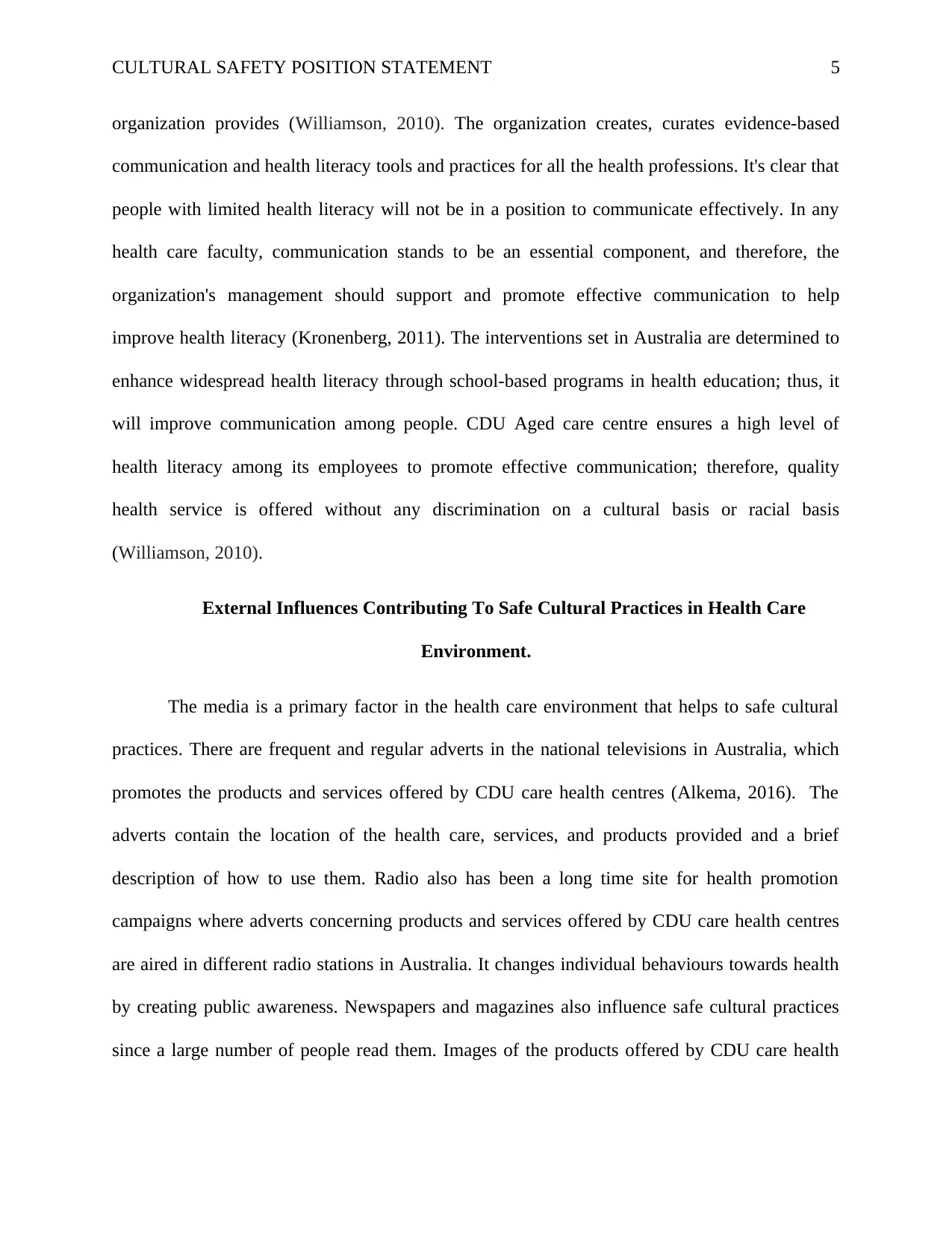
CULTURAL SAFETY POSITION STATEMENT 5
organization provides (Williamson, 2010). The organization creates, curates evidence-based
communication and health literacy tools and practices for all the health professions. It's clear that
people with limited health literacy will not be in a position to communicate effectively. In any
health care faculty, communication stands to be an essential component, and therefore, the
organization's management should support and promote effective communication to help
improve health literacy (Kronenberg, 2011). The interventions set in Australia are determined to
enhance widespread health literacy through school-based programs in health education; thus, it
will improve communication among people. CDU Aged care centre ensures a high level of
health literacy among its employees to promote effective communication; therefore, quality
health service is offered without any discrimination on a cultural basis or racial basis
(Williamson, 2010).
External Influences Contributing To Safe Cultural Practices in Health Care
Environment.
The media is a primary factor in the health care environment that helps to safe cultural
practices. There are frequent and regular adverts in the national televisions in Australia, which
promotes the products and services offered by CDU care health centres (Alkema, 2016). The
adverts contain the location of the health care, services, and products provided and a brief
description of how to use them. Radio also has been a long time site for health promotion
campaigns where adverts concerning products and services offered by CDU care health centres
are aired in different radio stations in Australia. It changes individual behaviours towards health
by creating public awareness. Newspapers and magazines also influence safe cultural practices
since a large number of people read them. Images of the products offered by CDU care health
organization provides (Williamson, 2010). The organization creates, curates evidence-based
communication and health literacy tools and practices for all the health professions. It's clear that
people with limited health literacy will not be in a position to communicate effectively. In any
health care faculty, communication stands to be an essential component, and therefore, the
organization's management should support and promote effective communication to help
improve health literacy (Kronenberg, 2011). The interventions set in Australia are determined to
enhance widespread health literacy through school-based programs in health education; thus, it
will improve communication among people. CDU Aged care centre ensures a high level of
health literacy among its employees to promote effective communication; therefore, quality
health service is offered without any discrimination on a cultural basis or racial basis
(Williamson, 2010).
External Influences Contributing To Safe Cultural Practices in Health Care
Environment.
The media is a primary factor in the health care environment that helps to safe cultural
practices. There are frequent and regular adverts in the national televisions in Australia, which
promotes the products and services offered by CDU care health centres (Alkema, 2016). The
adverts contain the location of the health care, services, and products provided and a brief
description of how to use them. Radio also has been a long time site for health promotion
campaigns where adverts concerning products and services offered by CDU care health centres
are aired in different radio stations in Australia. It changes individual behaviours towards health
by creating public awareness. Newspapers and magazines also influence safe cultural practices
since a large number of people read them. Images of the products offered by CDU care health
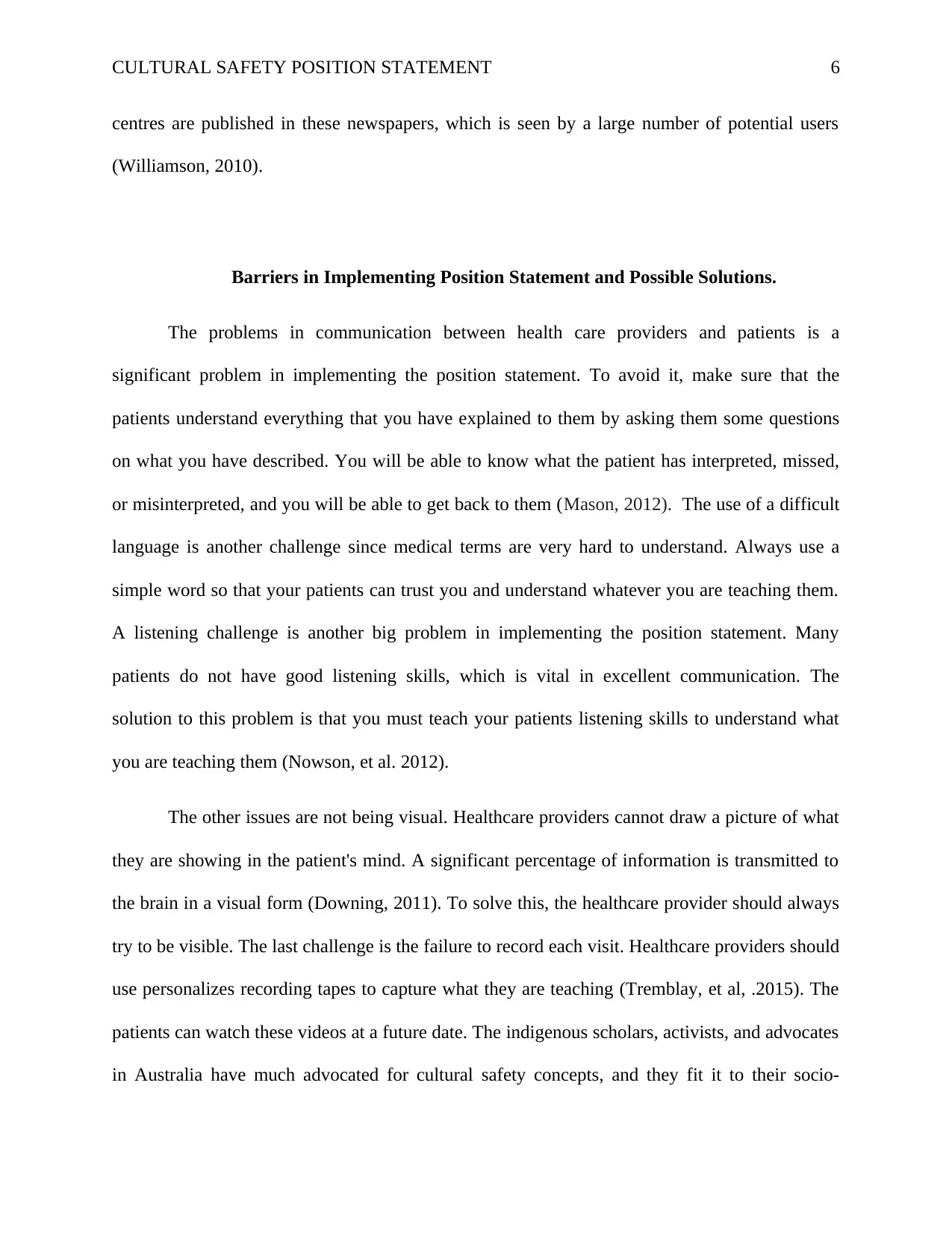
CULTURAL SAFETY POSITION STATEMENT 6
centres are published in these newspapers, which is seen by a large number of potential users
(Williamson, 2010).
Barriers in Implementing Position Statement and Possible Solutions.
The problems in communication between health care providers and patients is a
significant problem in implementing the position statement. To avoid it, make sure that the
patients understand everything that you have explained to them by asking them some questions
on what you have described. You will be able to know what the patient has interpreted, missed,
or misinterpreted, and you will be able to get back to them (Mason, 2012). The use of a difficult
language is another challenge since medical terms are very hard to understand. Always use a
simple word so that your patients can trust you and understand whatever you are teaching them.
A listening challenge is another big problem in implementing the position statement. Many
patients do not have good listening skills, which is vital in excellent communication. The
solution to this problem is that you must teach your patients listening skills to understand what
you are teaching them (Nowson, et al. 2012).
The other issues are not being visual. Healthcare providers cannot draw a picture of what
they are showing in the patient's mind. A significant percentage of information is transmitted to
the brain in a visual form (Downing, 2011). To solve this, the healthcare provider should always
try to be visible. The last challenge is the failure to record each visit. Healthcare providers should
use personalizes recording tapes to capture what they are teaching (Tremblay, et al, .2015). The
patients can watch these videos at a future date. The indigenous scholars, activists, and advocates
in Australia have much advocated for cultural safety concepts, and they fit it to their socio-
centres are published in these newspapers, which is seen by a large number of potential users
(Williamson, 2010).
Barriers in Implementing Position Statement and Possible Solutions.
The problems in communication between health care providers and patients is a
significant problem in implementing the position statement. To avoid it, make sure that the
patients understand everything that you have explained to them by asking them some questions
on what you have described. You will be able to know what the patient has interpreted, missed,
or misinterpreted, and you will be able to get back to them (Mason, 2012). The use of a difficult
language is another challenge since medical terms are very hard to understand. Always use a
simple word so that your patients can trust you and understand whatever you are teaching them.
A listening challenge is another big problem in implementing the position statement. Many
patients do not have good listening skills, which is vital in excellent communication. The
solution to this problem is that you must teach your patients listening skills to understand what
you are teaching them (Nowson, et al. 2012).
The other issues are not being visual. Healthcare providers cannot draw a picture of what
they are showing in the patient's mind. A significant percentage of information is transmitted to
the brain in a visual form (Downing, 2011). To solve this, the healthcare provider should always
try to be visible. The last challenge is the failure to record each visit. Healthcare providers should
use personalizes recording tapes to capture what they are teaching (Tremblay, et al, .2015). The
patients can watch these videos at a future date. The indigenous scholars, activists, and advocates
in Australia have much advocated for cultural safety concepts, and they fit it to their socio-
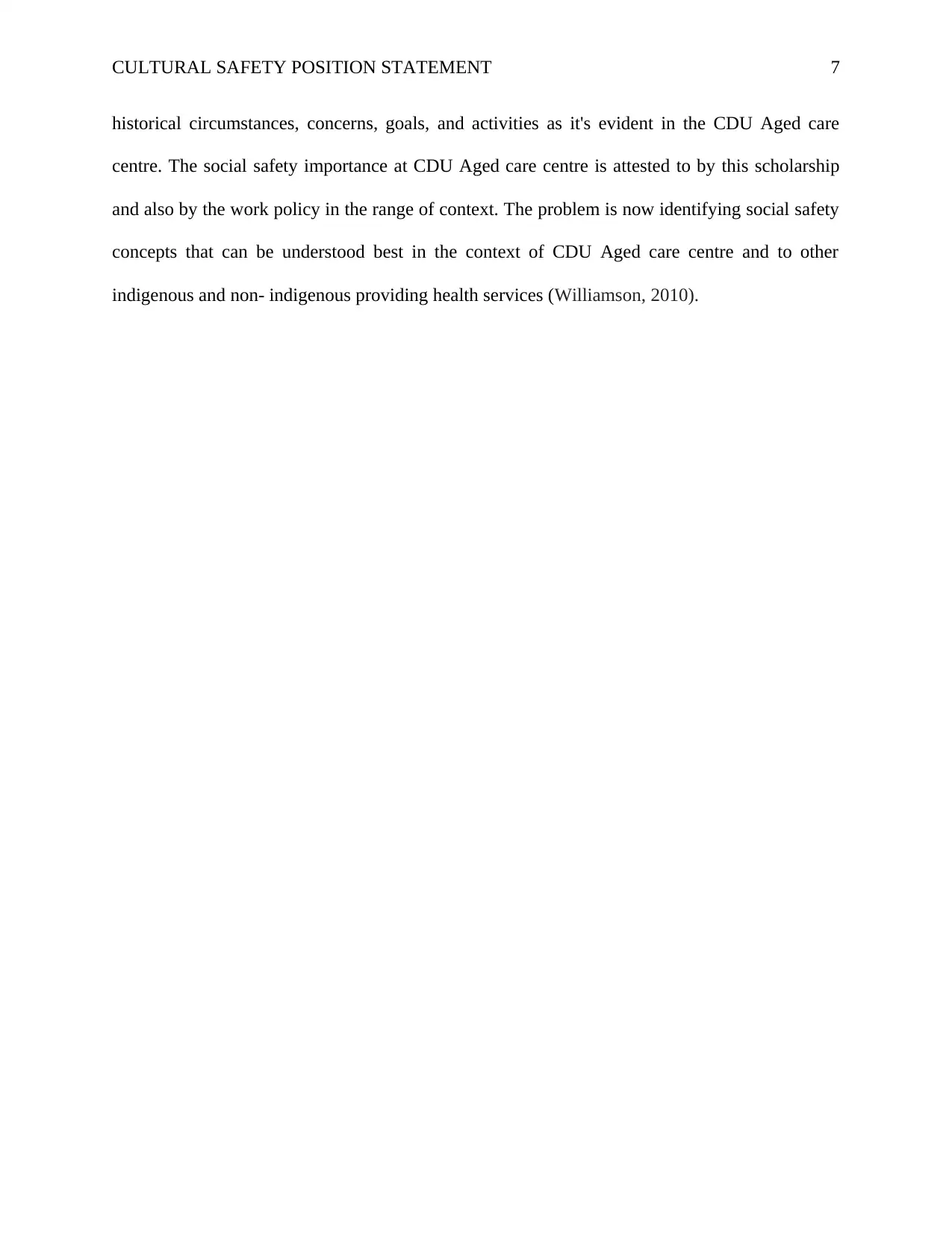
CULTURAL SAFETY POSITION STATEMENT 7
historical circumstances, concerns, goals, and activities as it's evident in the CDU Aged care
centre. The social safety importance at CDU Aged care centre is attested to by this scholarship
and also by the work policy in the range of context. The problem is now identifying social safety
concepts that can be understood best in the context of CDU Aged care centre and to other
indigenous and non- indigenous providing health services (Williamson, 2010).
historical circumstances, concerns, goals, and activities as it's evident in the CDU Aged care
centre. The social safety importance at CDU Aged care centre is attested to by this scholarship
and also by the work policy in the range of context. The problem is now identifying social safety
concepts that can be understood best in the context of CDU Aged care centre and to other
indigenous and non- indigenous providing health services (Williamson, 2010).
Paraphrase This Document
Need a fresh take? Get an instant paraphrase of this document with our AI Paraphraser
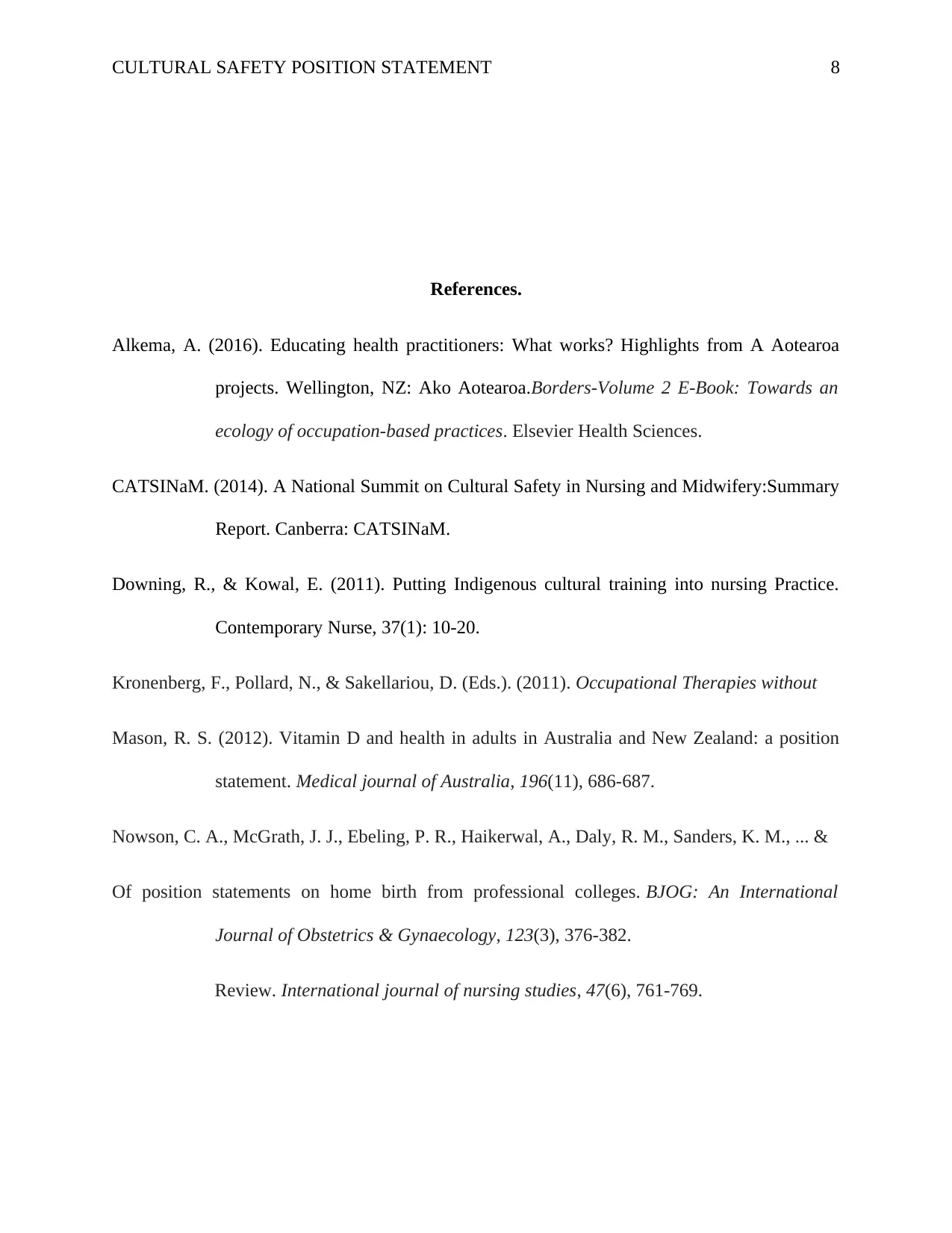
CULTURAL SAFETY POSITION STATEMENT 8
References.
Alkema, A. (2016). Educating health practitioners: What works? Highlights from A Aotearoa
projects. Wellington, NZ: Ako Aotearoa.Borders-Volume 2 E-Book: Towards an
ecology of occupation-based practices. Elsevier Health Sciences.
CATSINaM. (2014). A National Summit on Cultural Safety in Nursing and Midwifery:Summary
Report. Canberra: CATSINaM.
Downing, R., & Kowal, E. (2011). Putting Indigenous cultural training into nursing Practice.
Contemporary Nurse, 37(1): 10-20.
Kronenberg, F., Pollard, N., & Sakellariou, D. (Eds.). (2011). Occupational Therapies without
Mason, R. S. (2012). Vitamin D and health in adults in Australia and New Zealand: a position
statement. Medical journal of Australia, 196(11), 686-687.
Nowson, C. A., McGrath, J. J., Ebeling, P. R., Haikerwal, A., Daly, R. M., Sanders, K. M., ... &
Of position statements on home birth from professional colleges. BJOG: An International
Journal of Obstetrics & Gynaecology, 123(3), 376-382.
Review. International journal of nursing studies, 47(6), 761-769.
References.
Alkema, A. (2016). Educating health practitioners: What works? Highlights from A Aotearoa
projects. Wellington, NZ: Ako Aotearoa.Borders-Volume 2 E-Book: Towards an
ecology of occupation-based practices. Elsevier Health Sciences.
CATSINaM. (2014). A National Summit on Cultural Safety in Nursing and Midwifery:Summary
Report. Canberra: CATSINaM.
Downing, R., & Kowal, E. (2011). Putting Indigenous cultural training into nursing Practice.
Contemporary Nurse, 37(1): 10-20.
Kronenberg, F., Pollard, N., & Sakellariou, D. (Eds.). (2011). Occupational Therapies without
Mason, R. S. (2012). Vitamin D and health in adults in Australia and New Zealand: a position
statement. Medical journal of Australia, 196(11), 686-687.
Nowson, C. A., McGrath, J. J., Ebeling, P. R., Haikerwal, A., Daly, R. M., Sanders, K. M., ... &
Of position statements on home birth from professional colleges. BJOG: An International
Journal of Obstetrics & Gynaecology, 123(3), 376-382.
Review. International journal of nursing studies, 47(6), 761-769.
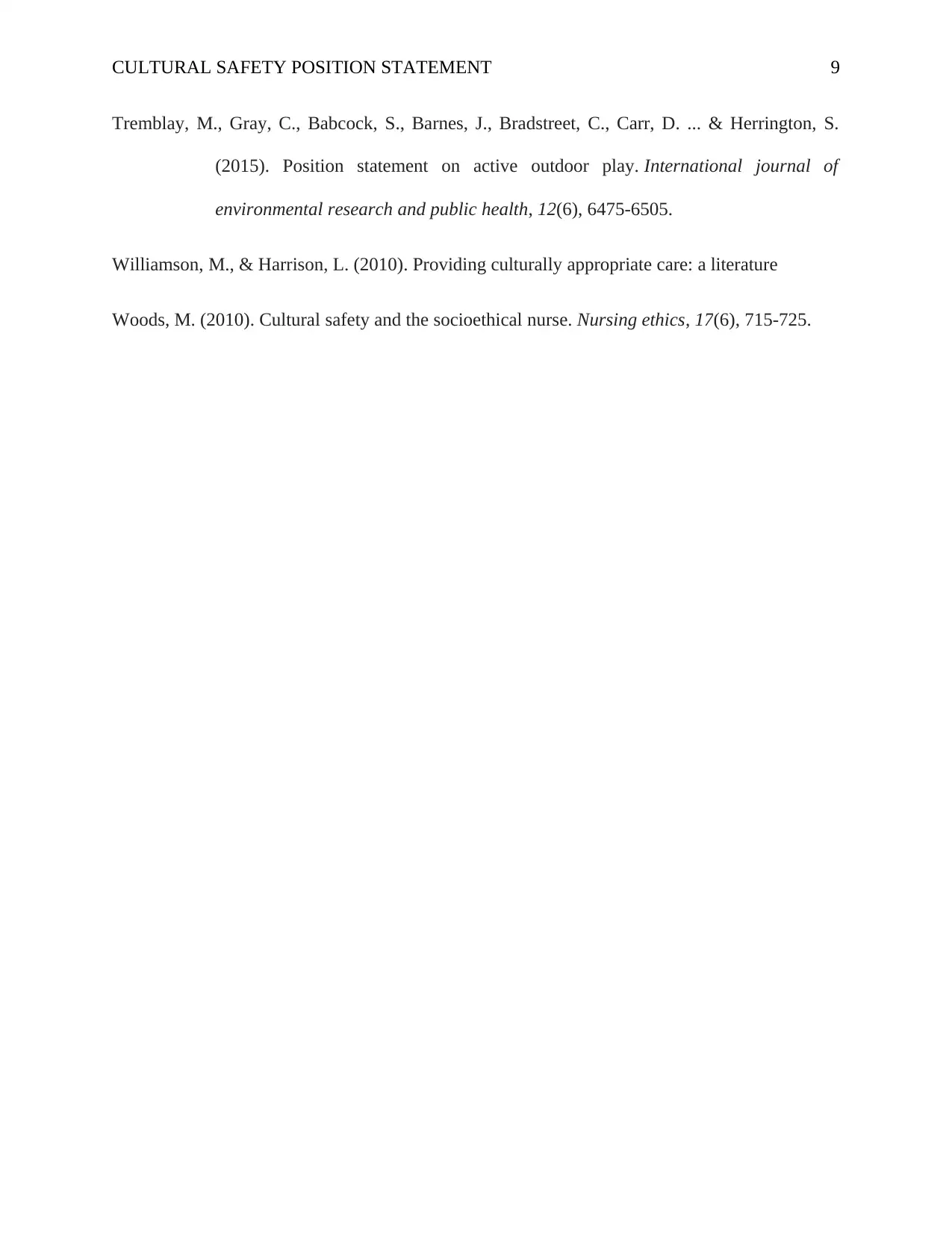
CULTURAL SAFETY POSITION STATEMENT 9
Tremblay, M., Gray, C., Babcock, S., Barnes, J., Bradstreet, C., Carr, D. ... & Herrington, S.
(2015). Position statement on active outdoor play. International journal of
environmental research and public health, 12(6), 6475-6505.
Williamson, M., & Harrison, L. (2010). Providing culturally appropriate care: a literature
Woods, M. (2010). Cultural safety and the socioethical nurse. Nursing ethics, 17(6), 715-725.
Tremblay, M., Gray, C., Babcock, S., Barnes, J., Bradstreet, C., Carr, D. ... & Herrington, S.
(2015). Position statement on active outdoor play. International journal of
environmental research and public health, 12(6), 6475-6505.
Williamson, M., & Harrison, L. (2010). Providing culturally appropriate care: a literature
Woods, M. (2010). Cultural safety and the socioethical nurse. Nursing ethics, 17(6), 715-725.
1 out of 9
Related Documents
Your All-in-One AI-Powered Toolkit for Academic Success.
+13062052269
info@desklib.com
Available 24*7 on WhatsApp / Email
![[object Object]](/_next/static/media/star-bottom.7253800d.svg)
Unlock your academic potential
© 2024 | Zucol Services PVT LTD | All rights reserved.





